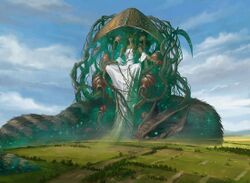Karametra
| Karametra | |
|---|---|
| God of Harvests | |
| Information | |
| Colors |
|
| Species | God |
| Birth, Life & Death | |
| Birthplace | Theros |

Karametra is the god of harvests, fertility, and family on the plane of Theros. Serene and nurturing, she embodies the domestic side of nature — one that sustains, shelters, and connects communities through the cycles of life. Karametra is deeply revered in Setessa, where her teachings shape everything from agriculture to parenthood. Though she stands apart from divine rivalries, her scythe and sable serve as reminders that what she nurtures, she also protects. In ancient times, her worship included darker rites, still preserved among the minotaurs.
Description
Karametra is the god of the hearth, agriculture, and maternal protection. She embodies serenity, generosity, and wisdom, offering her blessings to mortals through the cycles of nature and the bonds of community. Her influence touches every aspect of settled life—parenthood, domestication, food security, and seasonal renewal. While primarily a nurturing presence, Karametra also defends what she cultivates, and her power includes the strength to protect homes and lives when threatened.
Karametra appears as a motherly figure with long rows of leaflike hair that cover her eyes. She is typically seated on a throne formed of grapevines emerging from amphorae, shaded by a carved wooden canopy. A massive black sable, her loyal companion, rests at her feet, and she carries a curved harvester’s scythe—a symbol of both bounty and the natural laws of death and renewal.[1]
Influence
Karametra governs the realm of domesticated nature—fertile fields, tamed flocks, thriving households—and the emotional well-being that comes with these gifts. She represents not nature's wild chaos but its life-giving structure: order, growth, and nourishment. Her blessings are subtle but essential, and her absence is felt in failed crops, barren homes, and the erosion of communal life. Mortals seek her favor not out of fear of wrath, but to avoid the quiet despair that follows her withdrawal.
She is especially revered in Setessa, where families, teachers, and defenders of the young honor her in daily life. Her worshippers understand that she is not a god of glory or conquest, but of endurance, renewal, and the quiet strength of belonging. In her view, all mortal life is sacred, and even those who have been abandoned—orphans, widows, and refugees—fall under her wide protective embrace.[1]
Goals
Karametra’s goals center on the long-term flourishing of mortal life. She does not involve herself in petty divine rivalries or mortal politics, instead advocating for the physical, emotional, and communal health of people. While she champions peace and stability, Karametra is not naïve; she recognizes the necessity of fighting to protect one’s home, family, and future.[1]
Divine Relationships
Karametra stands apart from the feuds of the other gods, often serving as a trusted source of wisdom and comfort. Her most enduring bond is with Heliod, whose solar radiance she honors for its role in sustaining life. Though she finds his pride excessive, she respects his stability and moral order.
Her relationship with Nylea is more strained. Though both are gods of nature, Nylea views Karametra as having compromised the wild in service of civilization, while Karametra sees mortals and their societies as intrinsic parts of the natural world. Despite their philosophical differences, they instruct their followers to leave offerings at each other’s shrines in mutual respect.
Karametra harbors deep disdain for Mogis, whose love of violence and cruelty undermines everything she nurtures. She is also critical of Iroas, finding even his “noble” wars a tragic waste of mortal potential. Still, she acknowledges that battle may be necessary to defend the innocent, and shares common ground with Iroas in their opposition to Mogis’s brutality.[1]
Worship
Worship of Karametra is widespread across Theros. Even those who live in urban poleis depend on her for fertility, food, and family. Her shrines are common in households, farms, and marketplaces, with prayers focused on affirming her constancy and expressing gratitude for her abundance.
Each month, worshippers gather on the night of the full moon for a communal feast in her honor. These celebrations include blessings for new parents, rituals of community solidarity, and offerings of seasonal produce. Young couples often steal away into the woods in search of sweet berries—and one another—hoping for a blessing of fertility.[1]
History
Origins
In ancient times, Karametra’s worship included more primal, blood-based rituals, and this aspect is still honored among minotaur traditions.[1]
The Years of Rage
Though the cause of Karametra’s ancient fury is lost to history, legend tells of a time when, for an entire year, she laid waste to her temples and caused the land to withhold its bounty. Crops failed, and famine loomed as mortals faced starvation. In desperation, her priests led a unified act of devotion—nearly all of humanity fasted and prayed for seven days without rest, offering praise for her wisdom and generosity. Moved by their sincerity, Karametra relented, blessing the world with a miraculous grape harvest that cured illness and ended the famine. Since that time, statues of the harvest god are traditionally adorned with coiled grapevines around the left wrist in honor of her forgiveness.
Silence of the Gods
Like the other gods of Theros, Karametra was affected by the Silence of the Gods, a period in which divine intervention ceased and her favor could no longer be relied upon.[2]
Inspiration
Karametra draws inspiration from classical earth and fertility deities, particularly figures like Demeter and Rhea in Greek mythology. She embodies both the life-giving aspect of the land and the nurturing spirit of motherhood. Her throne of amphorae and companion sable symbolize her ties to domesticity, abundance, and subtle but fierce protection.
Gallery
Story appearances
In-game references
- Represented in:
- Associated cards:
- Depicted in:
- Quoted or referred to:
Inspiration
The character of Karametra is inspired by Demeter and her daughter Persephone, Greek goddesses of harvest and fertility, and Hestia, Greek goddess of the hearth.
References
- ↑ a b c d e f Wizards RPG Team (2020), D&D Mythic Odysseys of Theros, Wizards of the Coast
- ↑ Jenna Helland (April 2014). Theros: Godsend, Part I. Wizards of the Coast. ISBN 978-0-7869-6556-4.
External links
- Trick Jarrett (January 21, 2014). "Karametra". magicthegathering.com. Wizards of the Coast. Archived from the original on 2021-02-07.
- The Magic Creative Team (January 29, 2014). "The Gods of Born of the Gods". magicthegathering.com. Wizards of the Coast. Archived from the original on 2019-05-06.
- Mike McArtor (March 24, 2014). "Born's Gods". magicthegathering.com. Wizards of the Coast. Archived from the original on 2021-04-29.

